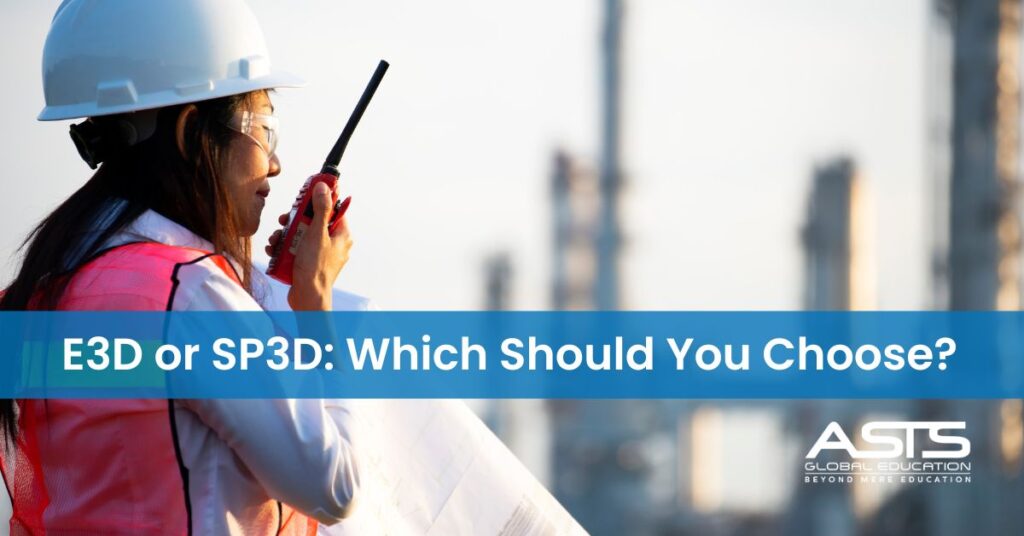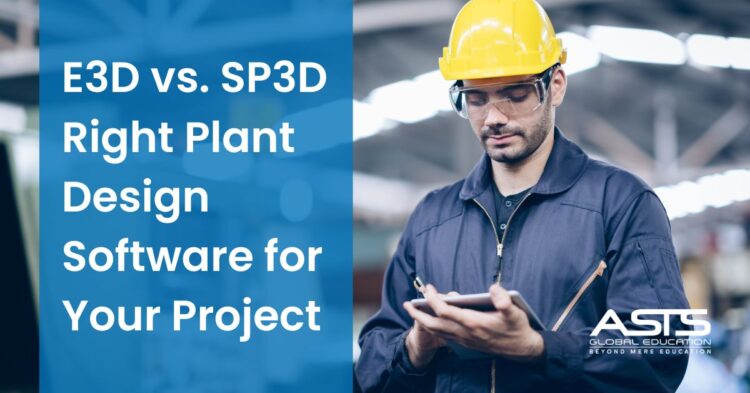Contents
Modelling and analysing new-age engineering plants, offshore platform structures and so on entail heavy capital outlay. Plant design tools for piping systems are critical elements of design and layout; with numerous plant design software tools available, it can be confusing to select the ideal one for your project.
In this blog, we will discuss two powerful 3D modelling software tools, E3D (AVEVA Everything3D) and SP3D (SmartPlant 3D) While both are used in engineering and design, they have different features, and are used for different purposes. We will explain the capabilities of each, so that you can choose the software that is best suited to your specific project. By examining SP3D vs E3D in detail, it will become easier to understand which software is ideal for you.

Let’s examine both the tools in detail to get a better understanding.
Aveva E3D (AVEVA Everything3D):
Everything 3D or E3D from Aveva is one of the most technologically advanced, powerful, and data-centric 3D design software platforms in the world. It comes with inbuilt simulation tools and analytical features that focus on energy-related projects. E3D is capable of generating accurate drawings of complex plants and equipment. It also generates reports that help to cut costs, reduce timescales, and mitigate commercial risks of greenfield and brownfield capital projects.
E3D offers best in class capabilities, enables multidisciplinary 3D design, and is capable of optimizing designs for performance and efficiency. It is used in diverse industries like power plants, oil and gas facilities, offshore platforms, chemical, and pharmaceuticals.
E3D software includes features like laser scanning, real-time clash detection, P&ID integration, intelligent drawing production, 3D visualization, simulation and analysis, and so on. Engineers can leverage these features to minimize design errors, reduce costs, and boost efficiency, eliminating the need for rework.
SP3D (SmartPlant 3D):
Smart Plant 3D from Hexagon focuses on data-driven design, visualization, and modelling of large and complex industrial plants like refineries, petrochemical plants, food and beverage, marine industries, offshore facilities, etc. SP3D helps to provide enhanced, superior quality designs and focuses on boosting productivity and reducing turnaround time.
Its features include intelligent object libraries, 3D modelling tools, collaboration capabilities, clash detection features, interference checking, materials management, and so on. These features enable SP3D to handle complex structural and piping designs and electrical components in industrial projects. The software is also capable of simulation, so that the engineers can see how the plant will operate when its built.
It has advanced tools that reduce mouse and keystrokes use and speed up designing, and promotes efficient design process. SP3D is capable of saving data integrity so that it can be reused during plant renovations and upgrades in the future.
Also Read
Best Aveva e3d Training Course in Mumbai
Best Aveva e3d Training Course in Chennai
Best Aveva e3d Training Course in Hyderabad
Job opportunities in UAE for SP3D (SmartPlant 3D)
If you search for SP3D jobs in UAE, you will get multiple jobs openings in UAE, sites like naukrigulf,
Most of the listing in SmartPlant 3D (SP3D) job roles demand strong proficiency in 3D plant modeling, with expertise in tools like SP3D, AutoCAD, MicroStation, and occasionally PDMS or PDS.
Candidates are expected to have discipline-specific skills in piping, electrical, instrumentation, and civil/structural design.
Familiarity with engineering standards and tools such as Caesar II is often required, particularly for stress analysis in piping systems.
Employers look for professionals with relevant experience in Oil & Gas, EPC, or FEED projects, typically ranging from 5 to 20 years.
A solid understanding of industry codes, project deliverables, and cross-discipline collaboration is also crucial for success in these roles.
Aveva E3D Vs SP3D

As you can see, both are powerful and popular 3D tools used in designing and modelling of industrial projects. However, E3D is more widely used in the energy and power sectors while SP3D is used in large industrial plants. For example, for power plants and renewable energy installations, E3D is likely to be the better choice while SP3D is ideal for refineries and petrochemical factories.
There isn’t a great deal to choose when we compare SP3D vs E3D. Both tools offer excellent design modelling capabilities, clash detection features, data management and interoperability, and facilitate smooth collaboration and teamwork among the stakeholders of the project. They also generate detailed isometric drawings, which are 2D representations of 3D models, used mainly for construction and fabrication.
The SP3D software costs less than E3D, which is actually an improved version of Aveva’s PDMS.
E3D is more focused on boosting productivity, increasing collaboration and the efficiency of the project. It integrates more easily with other software and engineering disciplines, and its clash detection capabilities are very robust.
The main difference between E3D and SP3D lies in the cost.
Also Read:
SP3D course in Hyderabad
SP3D course in Bangalore
SP3D course in Chennai
Aveva E3D or SP3D: Which Should You Choose?

While this decision depends on a number of factors like the type and size of the project, your budget, and team expertise, we can still suggest the following:
- E3D may be more suitable for power plants and renewable energy installation projects
- SP3D may be more suitable for large industrial projects like refineries, petrochemical facilities, pharma factories, and so on.
- If you have severe budget constraints, you may have to go with SP3D as it is less expensive than E3D.
- If your team is very familiar with E3D and you have no time to provide training for them to learn SP3D, you may choose E3D.
- If you need extensive integration with other engineering tools or multi-discipline integration, E3D has the edge in this regard.
E3D is considered the industry leader as it has been around for some time. However, SP3D is rapidly catching in popularity thanks to its intuitive UI and more affordable cost.
Conclusion
We have seen quite clearly that both E3D and SP3D have their own benefits and purposes, and are suitable for different type of projects. It is not possible to have a one-size-fits-all approach. There is no one right answer. Each project will have to be analysed in detail to determine its requirements, and the software that best suits those requirements should be chosen.
Matching existing software capabilities and strengths, resources, and project requirements is critical to make this decision. Both are powerful software tools that make the life of an engineer easier by creating detailed drawings of all components no matter how small or large.
Before making a decision to commit to a particular software solution, we highly recommend that you do some research on your own. Ask for product demos, and trial versions which your team can use and check its suitability for your project. In this way, you will have a clearer picture about which software is ideal.
If you are looking to learn SP3D online course or E3d Online Course then ASTS Global is the best option for you to upskill your knowledge.
Q: What are the main differences between Aveva E3D and SP3D?
A: E3D and SP3D are both powerful 3D modelling software tools used in industrial projects, but they differ in their focus and features. E3D, or Aveva Everything3D, excels in energy-related projects with its advanced simulation tools, while SP3D from Hexagon caters to large industrial plants like refineries and petrochemical facilities. Explore our detailed comparison to understand their distinctions further.
Q: How do I decide between Aveva E3D and SP3D for my project?
A: Choosing between E3D and SP3D depends on various factors such as project type, budget, and team expertise. E3D may be suitable for power plants and renewable energy installations, while SP3D may be more suitable for large industrial projects like refineries and petrochemical facilities. Consider your project requirements carefully to make the right decision.
Q: Where can I learn more about mastering Aveva E3D or SP3D for my career?
A: If you’re interested in mastering E3D or SP3D for your career advancement, consider enrolling in our comprehensive course on plant design software. ASTS Global’s Piping Design and Engineering courses cover everything you need to know about both E3D and SP3D, from basic functionalities to advanced techniques. Take the first step towards becoming a proficient user by exploring our course page.

